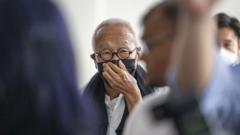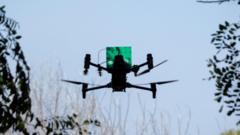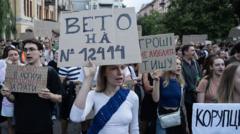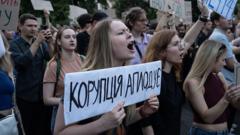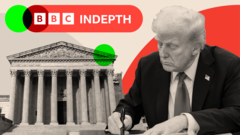Iliescu's political journey illustrates the duality of hope and conflict during Romania's tumultuous transition, leaving a legacy marked by achievements yet shadowed by violence and unresolved issues.
**Ion Iliescu: Romania's Complex Democratic Architect Passes at 95**
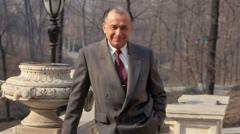
**Ion Iliescu: Romania's Complex Democratic Architect Passes at 95**
The former president's legacy reflects both triumphs and controversies in Romania's emergence from communism.
Ion Iliescu, a pivotal figure in Romania's political landscape, has died at the age of 95, bringing to a close the life of a leader closely associated with the country's transformation from a communist regime to a democracy. Iliescu, who was president during critical moments in the 1990s, is remembered as both a guiding force and a controversial figure, evoking mixed sentiments among Romanians regarding his lasting impact.
Political analyst Teodor Tita remarks, "To grasp Iliescu's essence, one must comprehend the intricate layers of Romania's 1990s." His leadership came to prominence during the December 1989 revolution that overthrew Nicolae Ceausescu's dictatorship, a period marked by hope for a democratic future. Yet, Iliescu's path has not been without its dark chapters, particularly the violent suppression of dissent and his connection to the oppressive systems he claimed to dismantle.
Born on March 3, 1930, in Oltenita, Iliescu was trained in engineering in Moscow, where he developed connections within the Romanian Communist Party. After falling from favor during the Ceausescu years, he re-emerged as a key figure in 1989, quickly gaining leadership in the National Salvation Front and transitioning into Romania's interim president. His popularity surged when he won the first democratic elections post-communism with an impressive 85% of the vote, despite the controversies surrounding the electoral processes that favored him.
However, Iliescu's rule is also marred by incidents like the 1990 Mineriads—a series of protests against his governance that escalated into violent confrontations, leading to significant casualties and public outcry. His administration grappled with corruption, a legacy of the previous regime, and faced accusations of allowing old communist structures to persist.
Despite these challenges, under Iliescu's presidency, Romania achieved significant milestones such as joining NATO and advancing toward European Union integration, while also initiating critical market reforms. Nevertheless, calls for accountability regarding past atrocities lingered, with legal actions stemming from the 1989 revolution and subsequent events continuing for years without satisfactory resolution.
Following his departure from active politics, Iliescu maintained a role within the Social Democratic Party, ultimately taking on an honorary presidency. Although he retreated from public life, he occasionally shared insights through his blog, with his last notable post expressing congratulations to a successor.
In retrospect, Tita describes Iliescu's political persona as one of "ruthless skill" that navigated Romania's complex social fabric; a legacy that merges the monumental with the painful, a testament to a nation still grappling to define its democracy.
Political analyst Teodor Tita remarks, "To grasp Iliescu's essence, one must comprehend the intricate layers of Romania's 1990s." His leadership came to prominence during the December 1989 revolution that overthrew Nicolae Ceausescu's dictatorship, a period marked by hope for a democratic future. Yet, Iliescu's path has not been without its dark chapters, particularly the violent suppression of dissent and his connection to the oppressive systems he claimed to dismantle.
Born on March 3, 1930, in Oltenita, Iliescu was trained in engineering in Moscow, where he developed connections within the Romanian Communist Party. After falling from favor during the Ceausescu years, he re-emerged as a key figure in 1989, quickly gaining leadership in the National Salvation Front and transitioning into Romania's interim president. His popularity surged when he won the first democratic elections post-communism with an impressive 85% of the vote, despite the controversies surrounding the electoral processes that favored him.
However, Iliescu's rule is also marred by incidents like the 1990 Mineriads—a series of protests against his governance that escalated into violent confrontations, leading to significant casualties and public outcry. His administration grappled with corruption, a legacy of the previous regime, and faced accusations of allowing old communist structures to persist.
Despite these challenges, under Iliescu's presidency, Romania achieved significant milestones such as joining NATO and advancing toward European Union integration, while also initiating critical market reforms. Nevertheless, calls for accountability regarding past atrocities lingered, with legal actions stemming from the 1989 revolution and subsequent events continuing for years without satisfactory resolution.
Following his departure from active politics, Iliescu maintained a role within the Social Democratic Party, ultimately taking on an honorary presidency. Although he retreated from public life, he occasionally shared insights through his blog, with his last notable post expressing congratulations to a successor.
In retrospect, Tita describes Iliescu's political persona as one of "ruthless skill" that navigated Romania's complex social fabric; a legacy that merges the monumental with the painful, a testament to a nation still grappling to define its democracy.


